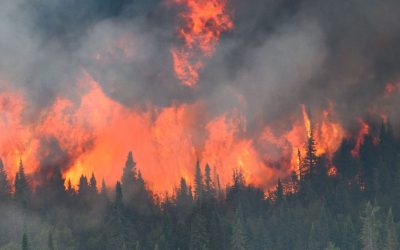WASHINGTON, Nov. 16 /PRNewswire/ — Today 11 climate experts sent a letter (see below) to Senator John McCain (R-AZ), who is the Chairman of the Senate Commerce, Science and Transportation committee and is holding a full committee hearing this morning to hear testimony on the Arctic Climate Impact Assessment (ACIA).
In the letter, the climate experts respond to statements made in the ACIA that temperature changes in the Arctic provide an early indication of global warming. The signers of the letter point out that sediment and ice core samples show that the arctic has experienced past warming that can not be attributed to greenhouse gas concentrations. There is also a history of strong year-to-year variability of Arctic temperatures. The letter also calls for the need for advances in Arctic climate science in both models and measurements in order to assess a more complete picture of Arctic climate understanding.
November 16, 2004
The Honorable John McCain
United States Senate
Washington, DC 20510
Dear Senator McCain:
As you know, climate varies in the Arctic more than globally-averaged measures reveal, prompting not inconsiderable ecosystem responses.
The Arctic Climate Impact Assessment report by the Arctic Council documents significant ecosystem response to surface temperature warming trends that occurred in some areas since the mid-19th century and in the last thirty years.
Estimates of the amount of surface warming trends over those periods and their causes relies on scientific knowledge of natural and anthropogenic effects, the latter including landscape modification, urbanization, plus the air’s concentration of aerosols and greenhouse gases. Moreover, Arctic climate varies dramatically from one region to another, and over time in ways that cannot be accurately reproduced by climate models. The quantitative impacts of natural and anthropogenic factors remain highly uncertain, especially for a region as complex as the Arctic.
For example, for Greenland’s instrumental surface temperatures a team of experts headed at Los Alamos National Laboratory recently found:
Since 1940, however, the Greenland coastal stations data have undergone predominantly a cooling trend. At the summit of the Greenland ice sheet, the summer average temperature has decreased at the rate of 2.2 degrees C per decade since the beginning of the measurements in 1987. This suggests that the Greenland ice sheet and coastal regions are not following the
current global warming trend.(1)
Analysis of ice corings of the Penny Ice Cap on Baffin Island show that the recent warming trend is unexceptional compared to natural variability in centuries past, when the enhanced greenhouse effect cannot have had much impact:
Our sea-salt record suggests that, while the turn of the [21st] century was characterized by generally milder sea-ice conditions in Baffin Bay, the last few decades of sea-ice extent lie within Little Ice Age variability and correspond to instrumental records of lower temperatures in the Eastern Canadian Arctic over the past three decades.(2)
From a detailed study of sea core sediment from the last 10,000 years in the Chukchi Sea, researchers concluded that, “in the recent past, the western Arctic Ocean was much warmer than it is today.” They also found that “during the middle Holocene [approximately 6,000 years ago] the August sea surface temperature fluctuated by 5 degrees C and was 3-7 degrees C warmer than it is today.”(3)
The relatively recent discovery of the PDO, or Pacific Decadal Oscillation(4), points to a strong natural component of the recent warming trend. Researchers noted in 1997:
Our results add support to those of previous studies suggesting that the climatic regime shift of the late 1970’s is not unique in the century-long instrumental climate record, nor in the record of North Pacific salmon production. In fact, we find that signatures of a recurring pattern of interdecadal climate variability are widespread and detectable in a variety of Pacific basin climate and ecological systems. This climate pattern — hereafter referred to as the Pacific (inter)Decadal Oscillation, or PDO (following co-author S.R.H.’s suggestion) — is a pan-Pacific phenomenon that also includes interdecadal climate variability in the tropical Pacific.
The Great Pacific Climate Shift of 1976-1977 is typical in the documented pattern of natural climate fluctuations going back at least several centuries. In Alaska in particular, although the onset of the 1976-1977 shift ended the several-decades-long period of cold in the middle of the 20th century recorded by many of Alaska’s good weather station records, it returned temperatures to warmth seen in the early decades of the 20th century. Thus, it is unsurprising that Alaskan ecosystems have responded to recent warmth, which has the characteristic step-upward shape of the PDO, but not the gradual but large warming trend implied by the enhanced greenhouse effect.
The PDO may have shifted back in 1998-99 to its mid-20th century state, which would tend to deliver sharply cooler temperatures in the next several decades to the western U.S., including western and southern Alaska. For example, scientists from British Columbia’s Institute of Ocean Sciences, Fisheries and Oceans and Oregon State University’s College of Oceanic and Atmospheric Sciences found recent cooling of the North Pacific:
Subsurface upper ocean waters off Oregon and Vancouver Island were about 1 degree C cooler in July 2002 than in July 2001. The anomalously cool layer coincides with the permanent halocline which has salinities 32.2 to 33.8, suggesting an invasion of nutrient-rich Subarctic waters. The anomalously cool layer lies at 30-150 m.(5)
Surface air temperatures (SAT) going back 125 years were studied from “newly available long-term Russian observations of SAT from coastal stations, and sea-ice extent and fast-ice thickness from the Kara, Laptev, East Siberian, and Chuckchi seas.”(6) Those researchers found “strong intrinsic variability, dominated by multi-decadal fluctuations with a timescale of 60-80 years.” Comparing those measures of Arctic regional variability to that of computer simulations, the researchers concluded that observations do “not support amplified warming in Polar Regions predicted by GCMs [General Circulation Models].”
A comprehensive study of Arctic temperature records(7) found that “in the Arctic in the period 1951-90, no tangible manifestations of the greenhouse effect can be identified.” However, strong year-to-year variability is present, as the researcher notes that “a more recent analysis of mean seasonal and annual air-temperature trends in the Arctic (Przybylak, in press) shows that in the mid-1990s there occurred quite a large rise in air temperature,” and as a consequence, “the areally averaged annual air temperature for the whole Arctic for the last 5 year period of the 20th century was the warmest since 1950 (1.0 degree C above the 1951-90 average).”
Those examples demonstrate that Arctic climate has and will continue to exhibit intricate patterns not reliably reproduced by global climate simulations, thus underscoring their scientific incompleteness and need for advances in Arctic climate science, in measurements, theory and models.
The history of the Arctic and its ecosystems remains complex, a fact too often perceived by reporters under deadline or extremists as irrelevant nuance. Ecosystems and humans survived the warming at the beginning of the 20th century, as they survived the warmth from A.D. 900 to 1200, when Thule people migrated from Alaska across the Arctic while Vikings farmed in Greenland soil now permafrost and sailed in Arctic waters now permanent pack ice. They survived the warming of the last 15,000 years as earth emerged from the last glacial period, whose termination produced much more radical temperature shocks than those observed in the last several decades.
As Professor Richard Lindzen, Alfred P. Sloan Professor of Meteorology at the Massachusetts Institute of Technology and IPCC author concluded in testimony before your May 1, 2001 Commerce Committee hearing:
The question of where do we go from here is an obvious and important one. From my provincial perspective, an important priority should be given to figuring out how to support and encourage science (and basic science underlying climate in particular) while removing incentives to promote alarmism. The benefits of leaving future generations a better understanding of nature would far outweigh the benefits (if any) of ill-thought out attempts to regulate nature in the absence of such understanding.
We appreciate your efforts to support scientific fact-finding concerning responses of Arctic ecosystems to climate variability.
Sincerely,
R. Tim Patterson, PhD, Professor of Geology, Carleton University
Tim Ball, PhD, Retired, Professor of Climatology, University of Winnipeg
Anthony Lupo, PhD, Professor of Atmospheric Science, University of Missouri – Columbia
David Legates, PhD, Associate Professor in Climatology, University of Delaware
Pat Michaels, PhD, Professor of Environmental Sciences, University of Virginia, Virginia State Climatologist
George Taylor, M.S. Meteorology, Oregon State Climatologist
Gary D. Sharp, PhD, Scientific Director, Center for Climate/Ocean Resources Study
Roy W. Spencer, PhD, Principal Research Scientists, The University of Alabama in Huntsville
Jon Reisman, Associate Professor of Economics and Public Policy, University of Maine at Machias, Maine Public Policy Institute Scholar
Willie Soon, PhD, Science Director, Tech Central Station
Sallie Baliunas, PhD, Enviro-Science Editor, Tech Central Station
(1) P. Chylek, J.E. Box and G. Lesins. 2004 Global warming and the Greenland ice sheet, Climatic Change 63 201-221
(2) N. S. Grumet, C.P. Wake, P.A. Mayewski, G.A. Zielinski, S.I. Whitlow, R.M. Koerner, D.A. Fisher, and J.M. Woollett. 2001, Variability of sea-ice extent in Baffin Bay over the last millennium, Climatic Change 49, 129-145
(3) D. Darby, J. Bischof, G. Cutter, A. de Vernal, C. Hillaire-Marcel, G. Dwyer, J. McManus, L. Osterman, L. Polyak and R. Poore. 2001, New record shows pronounced changes in Arctic Ocean circulation and climate. EOS, Transactions, American Geophysical Union 82, 601 and 607
(4) N. J. Mantua, S. R. Hare, Y. Zhang, J. M. Wallace and R. C. Francis. 1997, A Pacific interdecadal climate oscillation with impacts on salmon production, Bulletin of the American Meteorological Society 78, 1069-1079
(5) H. J. Freelnad, G. Gatien, A. Huyer, and R. L. Smith. 2003, Cold halocline in the northern California Current: An invasion of subarctic water. Geophysical Research Letters 30: 10.1029/2002GL016663.
(6) I. V. Polyakov, G.V. Alekseev, R.V. Bekryaev,U. Bhatt, R.L. Colony, M. A. Johnson, V.P. Karklin, A.P. Makshtas, D. Walsh, A. V. Yulin. 2002, Observationally based assessment of polar amplification of global warming. Geophysical Research Letters 29: 10.1029/2001GL011111.
(7) R. Przybylak. 2002, Changes in seasonal and annual high-frequency air temperature variability in the Arctic from 1951-1990, International Journal of Climatology 22, 1017-1032
Source: Tech Central Station, Tuesday November 16, 2004


